- GCN/BACODINE POSITION NOTICE
TITLE: GCN/SWIFT NOTICE
NOTICE_DATE: Mon 04 Sep 06 02:31:17 UT
NOTICE_TYPE: Swift-BAT GRB Position
TRIGGER_NUM: 228006, Seg_Num: 0
GRB_RA: 58.213d {+03h 52m 51s} (J2000),
58.298d {+03h 53m 12s} (current),
57.576d {+03h 50m 18s} (1950)
GRB_DEC: -0.720d {-00d 43' 11"} (J2000),
-0.700d {-00d 42' 01"} (current),
-0.868d {-00d 52' 04"} (1950)
GRB_ERROR: 3.00 [arcmin radius, statistical only]
GRB_INTEN: 2933 [cnts] Image_Peak=162 [image_cnts]
TRIGGER_DUR: 0.512 [sec]
TRIGGER_INDEX: 124 E_range: 25-100 keV
BKG_INTEN: 34137 [cnts]
BKG_TIME: 9046.57 SOD {02:30:46.57} UT
BKG_DUR: 8 [sec]
GRB_DATE: 13982 TJD; 247 DOY; 06/09/04
GRB_TIME: 9063.85 SOD {02:31:03.85} UT
GRB_PHI: 67.74 [deg]
GRB_THETA: 26.22 [deg]
SOLN_STATUS: 0x3
RATE_SIGNIF: 15.52 [sigma]
IMAGE_SIGNIF: 8.68 [sigma]
MERIT_PARAMS: +1 +0 +0 +0 +2 +11 +0 +0 +25 +1
SUN_POSTN: 162.87d {+10h 51m 30s} +7.27d {+07d 16' 28"}
SUN_DIST: 104.55 [deg] Sun_angle= 7.0 [hr] (West of Sun)
MOON_POSTN: 293.02d {+19h 32m 04s} -26.54d {-26d 32' 16"}
MOON_DIST: 120.75 [deg]
MOON_ILLUM: 82 [%]
GAL_COORDS: 189.44,-39.13 [deg] galactic lon,lat of the burst (or transient)
ECL_COORDS: 55.79,-20.46 [deg] ecliptic lon,lat of the burst (or transient)
COMMENTS: SWIFT-BAT GRB Coordinates.
COMMENTS: This is a rate trigger.
COMMENTS: A point_source was found.
COMMENTS: This does not match any source in the on-board catalog.
COMMENTS: This does not match any source in the ground catalog.
COMMENTS: This is a GRB.
COMMENTS: This trigger occurred at longitude,latitude = 102.25,14.15 [deg].
- red DSS finding chart
ps-file
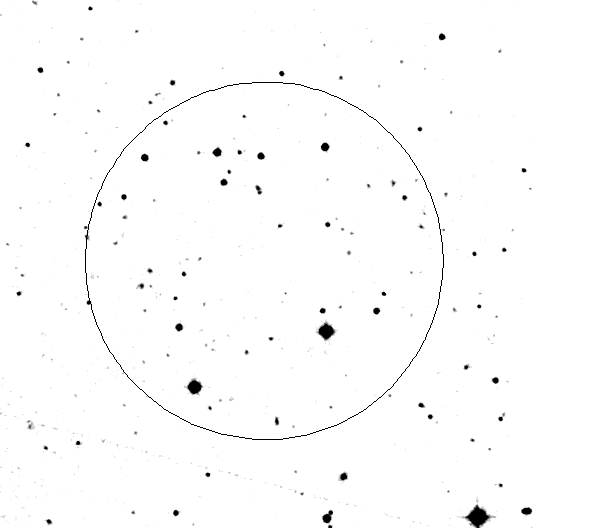
- GCN NOTICE
TITLE: GCN/SWIFT NOTICE
NOTICE_DATE: Mon 04 Sep 06 02:42:39 UT
NOTICE_TYPE: Swift-UVOT Processed Image
TRIGGER_NUM: 228006, Seg_Num: 0
POINT_RA: 58.214d {+03h 52m 51s} (J2000)
POINT_DEC: -0.723d {-00d 43' 21"} (J2000)
ROLL: 82.671d
IMG_START_DATE: 13982 TJD; 247 DOY; 06/09/04
IMG_START_TIME: 9134.21 SOD {02:32:14.21} UT, 70.4 [sec] since BAT Trigger Time
FILTER: 3, V
EXPOSURE_ID: 179029935
X_OFFSET: 760 [pixels]
Y_OFFSET: 927 [pixels]
WIDTH: 160 [pixels]
HEIGHT: 160 [pixels]
X_GRB_POS: 920
Y_GRB_POS: 1087
BINNING_INDEX: 1
IM_URL: sw00228006000msuni0070.fits
SUN_POSTN: 162.88d {+10h 51m 32s} +7.27d {+07d 16' 18"}
SUN_DIST: 104.55 [deg] Sun_angle= 7.0 [hr] (West of Sun)
MOON_POSTN: 293.14d {+19h 32m 34s} -26.52d {-26d 30' 57"}
MOON_DIST: 120.65 [deg]
MOON_ILLUM: 82 [%]
GAL_COORDS: 189.44,-39.13 [deg] galactic lon,lat of the pointing direction
ECL_COORDS: 55.79,-20.47 [deg] ecliptic lon,lat of the pointing direction
COMMENTS: SWIFT-UVOT Processed Image.
COMMENTS: The GRB Position came from the XRT Position Command.
COMMENTS: The image has 2x2 binning (compression).
COMMENTS: If you have elected to receive attachments:
COMMENTS: The uvot_catalog_image.fits.gz file does not exist; skipping the attachment.
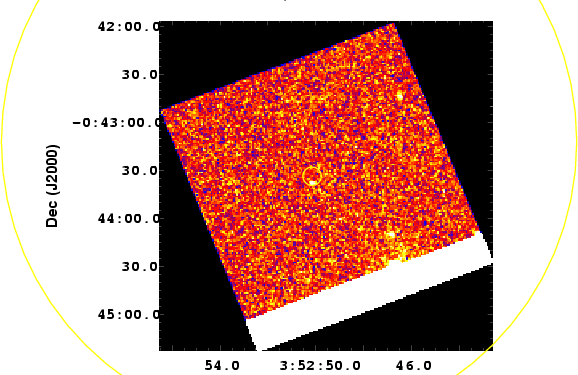
- GCN NOTICE
TITLE: GCN/SWIFT NOTICE
NOTICE_DATE: Mon 04 Sep 06 02:41:12 UT
NOTICE_TYPE: Swift-UVOT Processed Source List
TRIGGER_NUM: 228006, Seg_Num: 0
POINT_RA: 58.214d {+03h 52m 51s} (J2000)
POINT_DEC: -0.723d {-00d 43' 21"} (J2000)
POINT_ROLL: 82.671d
IMG_START_DATE: 13982 TJD; 247 DOY; 06/09/04
IMG_START_TIME: 9134.21 SOD {02:32:14.21} UT, 70.4 [sec] since BAT Trigger Time
FILTER: 3, V
BKG_MEAN: 2.793
N_STARS: 16
X_OFFSET: 440 [pixels]
Y_OFFSET: 607 [pixels]
X_MAX: 1399 [pixels]
Y_MAX: 1566 [pixels]
DET_THRESH: 14
PHOTO_THRESH: 7
SL_URL: sw00228006000msufc0070.fits
SUN_POSTN: 162.88d {+10h 51m 31s} +7.27d {+07d 16' 19"}
SUN_DIST: 104.55 [deg] Sun_angle= 7.0 [hr] (West of Sun)
MOON_POSTN: 293.12d {+19h 32m 30s} -26.52d {-26d 31' 07"}
MOON_DIST: 120.66 [deg]
MOON_ILLUM: 82 [%]
GAL_COORDS: 189.44,-39.13 [deg] galactic lon,lat of the pointing direction
ECL_COORDS: 55.79,-20.47 [deg] ecliptic lon,lat of the pointing direction
COMMENTS: SWIFT-UVOT Processed Source List.
COMMENTS: If you have elected to receive attachments:
COMMENTS: The uvot_catalog_srclist.fits.gz file does not exist; skipping the attachment.
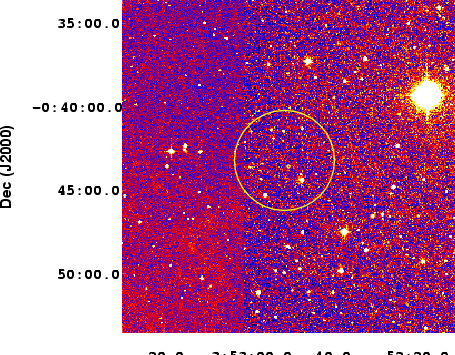
- GCN NOTICE
TITLE: GCN/SWIFT NOTICE
NOTICE_DATE: Mon 04 Sep 06 02:32:37 UT
NOTICE_TYPE: Swift-XRT Position
TRIGGER_NUM: 228006, Seg_Num: 0
GRB_RA: 58.2085d {+03h 52m 50.0s} (J2000),
58.2936d {+03h 53m 10.4s} (current),
57.5713d {+03h 50m 17.1s} (1950)
GRB_DEC: -0.7258d {-00d 43' 32.8"} (J2000),
-0.7062d {-00d 42' 22.4"} (current),
-0.8738d {-00d 52' 25.6"} (1950)
GRB_ERROR: 6.5 [arcsec radius, statistical plus systematic, 90% containment]
GRB_INTEN: 4.29e-10 [erg/cm2/sec]
GRB_SIGNIF: 4.79 [sigma]
IMG_START_DATE: 13982 TJD; 247 DOY; 06/09/04
IMG_START_TIME: 9132.66 SOD {02:32:12.66} UT, 68.8 [sec] since BAT Trigger Time
TAM[0-3]: 327.60 237.17 261.32 243.15
AMPLIFIER: 2
WAVEFORM: 134
SUN_POSTN: 162.88d {+10h 51m 30s} +7.27d {+07d 16' 27"}
SUN_DIST: 104.55 [deg] Sun_angle= 7.0 [hr] (West of Sun)
MOON_POSTN: 293.03d {+19h 32m 08s} -26.54d {-26d 32' 06"}
MOON_DIST: 120.73 [deg]
MOON_ILLUM: 82 [%]
GAL_COORDS: 189.44,-39.14 [deg] galactic lon,lat of the burst
ECL_COORDS: 55.79,-20.47 [deg] ecliptic lon,lat of the burst
COMMENTS: SWIFT-XRT Coordinates.
- GCN NOTICE
TITLE: GCN/SWIFT NOTICE
NOTICE_DATE: Mon 04 Sep 06 02:40:49 UT
NOTICE_TYPE: Swift-UVOT Source List
TRIGGER_NUM: 228006, Seg_Num: 0
POINT_RA: 58.214d {+03h 52m 51s} (J2000)
POINT_DEC: -0.723d {-00d 43' 21"} (J2000)
POINT_ROLL: 82.671d
IMG_START_DATE: 13982 TJD; 247 DOY; 06/09/04
IMG_START_TIME: 9134.21 SOD {02:32:14.21} UT, 70.4 [sec] since BAT Trigger Time
FILTER: 3, V
BKG_MEAN: 2.793
N_STARS: 16
X_OFFSET: 440 [pixels]
Y_OFFSET: 607 [pixels]
X_MAX: 1399 [pixels]
Y_MAX: 1566 [pixels]
DET_THRESH: 14
PHOTO_THRESH: 7
SL_URL: sw00228006000msufc0070.fits
SUN_POSTN: 162.88d {+10h 51m 31s} +7.27d {+07d 16' 19"}
SUN_DIST: 104.55 [deg] Sun_angle= 7.0 [hr] (West of Sun)
MOON_POSTN: 293.12d {+19h 32m 29s} -26.52d {-26d 31' 09"}
MOON_DIST: 120.66 [deg]
MOON_ILLUM: 82 [%]
GAL_COORDS: 189.44,-39.13 [deg] galactic lon,lat of the pointing direction
ECL_COORDS: 55.79,-20.47 [deg] ecliptic lon,lat of the pointing direction
COMMENTS: SWIFT-UVOT Source List.
- GCN NOTICE
TITLE: GCN/SWIFT NOTICE
NOTICE_DATE: Mon 04 Sep 06 02:32:38 UT
NOTICE_TYPE: Swift-XRT Image
TRIGGER_NUM: 228006, Seg_Num: 0
GRB_RA: 58.2085d {+03h 52m 50.0s} (J2000),
58.2936d {+03h 53m 10.4s} (current),
57.5713d {+03h 50m 17.1s} (1950)
GRB_DEC: -0.7258d {-00d 43' 32.8"} (J2000),
-0.7062d {-00d 42' 22.4"} (current),
-0.8738d {-00d 52' 25.6"} (1950)
GRB_ERROR: 6.5 [arcsec, radius, statistical plus systematic]
GRB_INTEN: 23 [cnts]
IMG_START_DATE: 13982 TJD; 247 DOY; 06/09/04
IMG_START_TIME: 9132.66 SOD {02:32:12.66} UT, 68.8 [sec] since BAT Trigger Time
CENTROID_X: 310.74, raw= 311 [pixels]
CENTROID_Y: 294.34, raw= 294 [pixels]
ROLL: 82.67 [deg]
GAIN: 1
MODE: 3, Long Image mode
WAVEFORM: 134
EXPO_TIME: 2.50 [sec]
GRB_POS_XRT_Y: -10.49
GRB_POS_XRT_Z: 22.26
IMAGE_URL: sw00228006000msxps_rw.img
SUN_POSTN: 162.88d {+10h 51m 30s} +7.27d {+07d 16' 27"}
SUN_DIST: 104.55 [deg] Sun_angle= 7.0 [hr] (West of Sun)
MOON_POSTN: 293.03d {+19h 32m 08s} -26.54d {-26d 32' 06"}
MOON_DIST: 120.73 [deg]
MOON_ILLUM: 82 [%]
GAL_COORDS: 189.44,-39.14 [deg] galactic lon,lat of the burst
ECL_COORDS: 55.79,-20.47 [deg] ecliptic lon,lat of the burst
COMMENTS: SWIFT-XRT Image.

- GCN NOTICE
TITLE: GCN/SWIFT NOTICE
NOTICE_DATE: Mon 04 Sep 06 02:34:40 UT
NOTICE_TYPE: Swift-BAT GRB Lightcurve
TRIGGER_NUM: 228006, Seg_Num: 0
GRB_RA: 58.213d {+03h 52m 51s} (J2000),
58.298d {+03h 53m 12s} (current),
57.576d {+03h 50m 18s} (1950)
GRB_DEC: -0.720d {-00d 43' 11"} (J2000),
-0.700d {-00d 42' 01"} (current),
-0.868d {-00d 52' 04"} (1950)
GRB_DATE: 13982 TJD; 247 DOY; 06/09/04
GRB_TIME: 9063.85 SOD {02:31:03.85} UT
TRIGGER_INDEX: 124
GRB_PHI: 67.74 [deg]
GRB_THETA: 26.22 [deg]
DELTA_TIME: 32.00 [sec]
TRIGGER_DUR: 0.512 [sec]
SOLN_STATUS: 0x3
RATE_SIGNIF: 15.52 [sigma]
IMAGE_SIGNIF: 8.68 [sigma]
LC_URL: sw00228006000msb.lc
SUN_POSTN: 162.88d {+10h 51m 30s} +7.27d {+07d 16' 25"}
SUN_DIST: 104.55 [deg] Sun_angle= 7.0 [hr] (West of Sun)
MOON_POSTN: 293.05d {+19h 32m 13s} -26.53d {-26d 31' 52"}
MOON_DIST: 120.72 [deg]
MOON_ILLUM: 82 [%]
GAL_COORDS: 189.44,-39.13 [deg] galactic lon,lat of the burst (or transient)
ECL_COORDS: 55.79,-20.46 [deg] ecliptic lon,lat of the burst (or transient)
COMMENTS: SWIFT-BAT GRB Lightcurve.
COMMENTS:
COMMENTS: The next comments were copied from the BAT_POS Notice:
COMMENTS: This is a rate trigger.
COMMENTS: A point_source was found.
COMMENTS: This does not match any source in the on-board catalog.
COMMENTS: This does not match any source in the ground catalog.
COMMENTS: This is a GRB.
COMMENTS: This trigger occurred at longitude,latitude = 102.25,14.15 [deg].
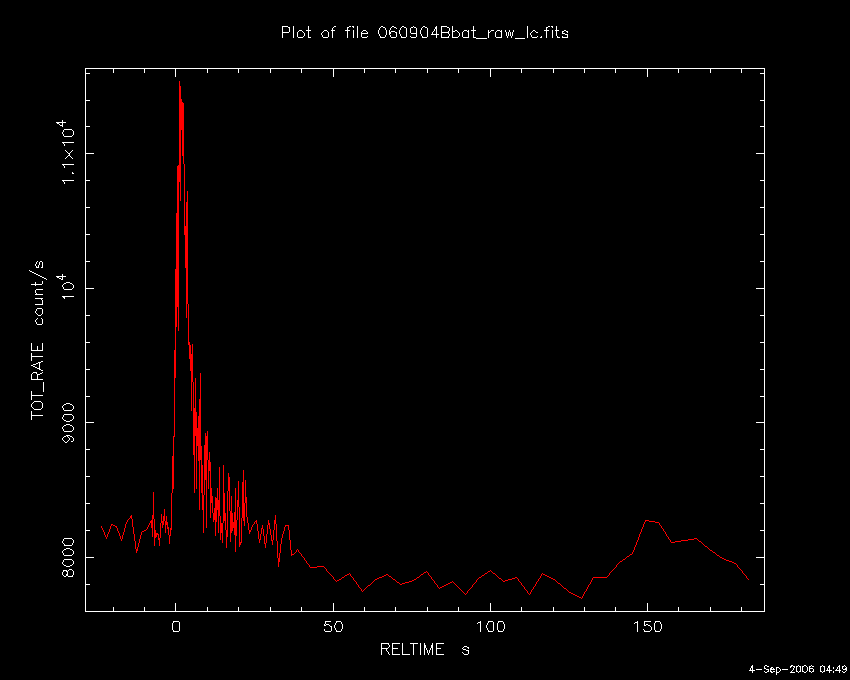
- GCN NOTICE
TITLE: GCN/SWIFT NOTICE
NOTICE_DATE: Mon 04 Sep 06 02:32:47 UT
NOTICE_TYPE: Swift-XRT Processed Image
TRIGGER_NUM: 228006, Seg_Num: 0
GRB_RA: 58.2085d {+03h 52m 50.0s} (J2000),
58.2936d {+03h 53m 10.4s} (current),
57.5713d {+03h 50m 17.1s} (1950)
GRB_DEC: -0.7258d {-00d 43' 32.8"} (J2000),
-0.7062d {-00d 42' 22.4"} (current),
-0.8738d {-00d 52' 25.6"} (1950)
GRB_ERROR: 6.5 [arcsec, radius, statistical plus systematic]
GRB_INTEN: 23 [cnts]
IMG_START_DATE: 13982 TJD; 247 DOY; 06/09/04
IMG_START_TIME: 9132.66 SOD {02:32:12.66} UT, 68.8 [sec] since BAT Trigger Time
CENTROID_X: 310.74, raw= 311 [pixels]
CENTROID_Y: 294.34, raw= 294 [pixels]
ROLL: 82.67 [deg]
GAIN: 1
MODE: 3, Long Image mode
WAVEFORM: 134
EXPO_TIME: 2.50 [sec]
GRB_POS_XRT_Y: -10.49
GRB_POS_XRT_Z: 22.26
IMAGE_URL: sw00228006000msxps_rw.img
SUN_POSTN: 162.88d {+10h 51m 30s} +7.27d {+07d 16' 27"}
SUN_DIST: 104.55 [deg] Sun_angle= 7.0 [hr] (West of Sun)
MOON_POSTN: 293.03d {+19h 32m 08s} -26.54d {-26d 32' 05"}
MOON_DIST: 120.73 [deg]
MOON_ILLUM: 82 [%]
GAL_COORDS: 189.44,-39.14 [deg] galactic lon,lat of the burst
ECL_COORDS: 55.79,-20.47 [deg] ecliptic lon,lat of the burst
COMMENTS: SWIFT-XRT Processed Image.

- GCN NOTICE
TITLE: GCN/SWIFT NOTICE
NOTICE_DATE: Mon 04 Sep 06 02:42:27 UT
NOTICE_TYPE: Swift-UVOT Image
TRIGGER_NUM: 228006, Seg_Num: 0
POINT_RA: 58.214d {+03h 52m 51s} (J2000)
POINT_DEC: -0.723d {-00d 43' 21"} (J2000)
ROLL: 82.671d
IMG_START_DATE: 13982 TJD; 247 DOY; 06/09/04
IMG_START_TIME: 9134.21 SOD {02:32:14.21} UT, 70.4 [sec] since BAT Trigger Time
FILTER: 3, V
EXPOSURE_ID: 179029935
X_OFFSET: 760 [pixels]
Y_OFFSET: 927 [pixels]
WIDTH: 160 [pixels]
HEIGHT: 160 [pixels]
X_GRB_POS: 920
Y_GRB_POS: 1087
BINNING_INDEX: 1
IM_URL: sw00228006000msuni0070.fits
SUN_POSTN: 162.88d {+10h 51m 31s} +7.27d {+07d 16' 18"}
SUN_DIST: 104.55 [deg] Sun_angle= 7.0 [hr] (West of Sun)
MOON_POSTN: 293.14d {+19h 32m 33s} -26.52d {-26d 30' 58"}
MOON_DIST: 120.65 [deg]
MOON_ILLUM: 82 [%]
GAL_COORDS: 189.44,-39.13 [deg] galactic lon,lat of the pointing direction
ECL_COORDS: 55.79,-20.47 [deg] ecliptic lon,lat of the pointing direction
COMMENTS: SWIFT-UVOT Image.
COMMENTS: The GRB Position came from the XRT Position Command.
COMMENTS: The image has 2x2 binning (compression).

- GCN Circular #5504
E.S. Rykoff (U Mich), W. Rujopakarn (U Mich), F. Yuan (U Mich), report
on behalf of the ROTSE collaboration:
ROTSE-IIIc, located at the H.E.S.S. site at Mt. Gamsberg, Namibia,
responded to GRB 060904A (Swift trigger 228006). The first image was at
02:31:22.4 UT, 18.5 s after the burst (5.3 s after the GCN notice time).
The unfiltered images are calibrated relative to USNO A2.0. We detect a
17.3 magnitude, brightening source with coordinates:
03:52:50.52 -00:43:30.85 (J2000)
start UT mag mlim(of image)
----------------------------------
02:31:22.4 17.3 18.1
A jpeg image is available at
http://www.rotse.net/images/gsb228006_3c011-020_key.jpg
Continuing observations are in progress.
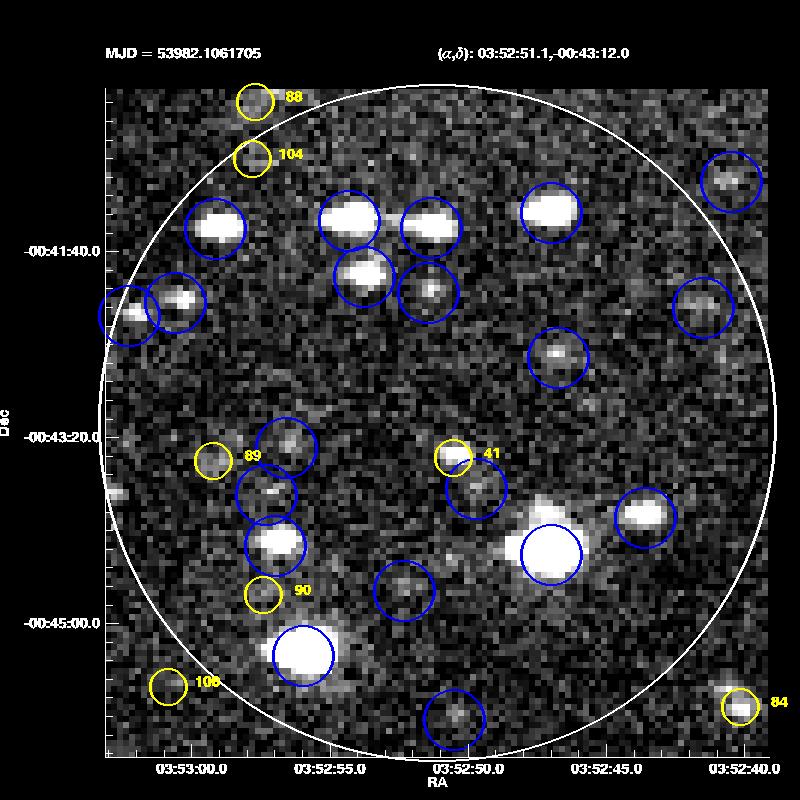
- GCN Circular #5505
D. Grupe (PSU), S. D. Barthelmy (GSFC), M. M. Chester (PSU),
J. R. Cummings (NASA/UMD), S. T. Holland (GSFC/USRA),
S. D. Hunsberger (PSU), J. A. Kennea (PSU), H. A. Krimm (GSFC/USRA),
C. B. Markwardt (GSFC/UMD), F. E. Marshall (NASA/GSFC),
D. M. Palmer (LANL), M. Stamatikos (NASA/ORAU) and M. C. Stroh (PSU)
report on behalf of the Swift Team:
At 02:31:03 UT, the Swift Burst Alert Telescope (BAT) triggered and
located GRB 060904B (trigger=228006). Swift slewed immediately to the burst.
The BAT on-board calculated location is
RA,Dec 58.213, -0.720 {03h 52m 51s, -00d 43' 11"} (J2000)
with an uncertainty of 3 arcmin (radius, 90% containment, including
systematic uncertainty). The BAT light curve shows an initial 5-sec wide
peak at T+1 sec followed by an ~30-sec wide weaker peak at T+150 sec.
The total duration is about 180 sec. The peak count rate
was ~3000 counts/sec (15-350 keV), at ~1 sec after the trigger.
The XRT began observing the field at 02:32:12 UT, 69 seconds after the
BAT trigger. XRT found a variable, uncatalogued X-ray source located
at RA(J2000) = 03h 52m 50.0s, Dec(J2000) = -00d 43' 32.8", with an
estimated uncertainty of 6.5 arcseconds (90% confidence radius). This
location is 26 arcseconds from the BAT on-board position, within the
BAT error circle. The initial flux in the 2.5s image was 4.3e-10
erg/cm2/s (0.2-10 keV). The source shows a rapid increase in count
rate indicating a bright flare that is possibly correlated with the
second bright peak in the BAT.
UVOT took a finding chart exposure of 246 seconds with the V filter
starting 70 seconds after the BAT trigger. There is a candidate afterglow in the
rapidly available 2.7'x2.7' sub-image at (RA,DEC) (J2000) of
(58.2106,-0.7253) or (03h52m50.54s,-00o43'31.1") with a 1-sigma
error radius of about 0.7 arc sec. This position is 7.7 arc sec. from
the center of the XRT error circle. The estimated magnitude is 18.6
with a 1-sigma error of about 0.5 mag. No correction has been made
for the expected extinction of about 0.6 magnitudes.
- GCN NOTICE
TITLE: GCN/SWIFT NOTICE
NOTICE_DATE: Mon 04 Sep 06 02:51:03 UT
NOTICE_TYPE: Swift-UVOT Position
TRIGGER_NUM: 228006, Seg_Num: 0
GRB_RA: 58.2105d {+03h 52m 50.52s} (J2000),
58.2956d {+03h 53m 10.94s} (current),
57.5733d {+03h 50m 17.58s} (1950)
GRB_DEC: -0.7252d {-00d 43' 30.7"} (J2000),
-0.7056d {-00d 42' 20.3"} (current),
-0.8732d {-00d 52' 23.4"} (1950)
GRB_ERROR: 0.4 [arcsec radius, statistical only]
GRB_MAG: 18.60 +/- 0.50 [mag]
FILTER: 3, V
IMG_START_DATE: 13982 TJD; 247 DOY; 06/09/04
IMG_START_TIME: 9134.00 SOD {02:32:14.00} UT, 70.1 [sec] since BAT Trigger Time
SUN_POSTN: 162.89d {+10h 51m 33s} +7.27d {+07d 16' 10"}
SUN_DIST: 104.56 [deg] Sun_angle= 7.0 [hr] (West of Sun)
MOON_POSTN: 293.23d {+19h 32m 55s} -26.50d {-26d 29' 58"}
MOON_DIST: 120.57 [deg]
MOON_ILLUM: 82 [%]
GAL_COORDS: 189.44,-39.14 [deg] galactic lon,lat of the burst (or transient)
ECL_COORDS: 55.79,-20.47 [deg] ecliptic lon,lat of the burst (or transient)
COMMENTS: SWIFT UVOT Position Notice.
COMMENTS: This Notice was ground-generated -- not flight-generated.
- GCN Circular #5507
Richard J. Cool (Arizona), Daniel J. Eisenstein (Arizona), David
W. Hogg (NYU), Michael R. Blanton (NYU), David J. Schlegel (LBNL),
J. Brinkmann (APO), Donald Q. Lamb (Chicago), Donald P. Schneider
(PSU), and Daniel E. Vanden Berk (PSU) report:
The Sloan Digital Sky Survey (SDSS) imaged the field of burst
GRB060904B prior to the burst. As these data should be useful
as a pre-burst comparison and for calibrating photometry, we are
supplying the images and photometry measurements for this GRB field
to the community.
Data from the SDSS, including 5 FITS images, 3 JPGS, and
3 files of photometry and astrometry, are being placed at
http://mizar.as.arizona.edu/~grb/public/GRB060904B
We supply FITS images in each of the 5 SDSS bands of a 8'x8'
region centered on the GRB position (ra=58.2130 (03:52:51.1),
dec=-0.720000 (-00:43:12.0); Swift-BAT TRIGGER 228006), as well as
3 gri color-composite JPGs (with different stretches). The units in
the FITS images are nanomaggies per pixel. A pixel is 0.396 arcsec
on a side. A nanomaggie is a flux-density unit equal to 10^-9 of
a magnitude 0 source or, to the extent that SDSS is an AB system,
3.631e-6 Jy. The FITS images have WCS astrometric information.
In the file GRB060904B_sdss.calstar.dat, we report photometry
and astrometry of 299 bright stars (r<20.5) within 15' of the
burst location. The magnitudes presented in this file are asinh
magnitudes as are standard in the SDSS (Lupton 1999, AJ, 118,
1406). Beware that some of these stars are not well-detected in
the u-band; use the errors and object flags to monitor data quality.
In the files GRB060904B_sdss.objects_flux.dat and
GRB060904B_sdss.objects_magnitudes.dat, we report photometry
of 1078 objects detected within 6' of the GRB position.
We have removed saturated objects and objects with model
magnitudes fainter than 23.0 in the r-band. The fluxes listed
in GRB060904B_sdss.objects_flux.dat are in nanomaggies while the
magnitudes listed in GRB060904B_sdss.objects_magnitudes.dat are
asinh magnitudes.
All quantities reported are standard SDSS photometry, meaning that
they are very close to AB zeropoints and magnitudes are quoted
in asinh magnitudes. Photometric zeropoints are known to about
2% rms. None of the photometry is corrected for dust extinction.
The Schlegel, Finkbeiner, and Davis (1998) predictions for this
region are A_U=0.899 mag, A_g=0.661 mag, A_r = 0.480 mag, A_i=0.364
mag, and A_z=0.258 mag.
The file GRB060904B_sdss.spectro.dat contains a list of the 18
objects with SDSS spectroscopy within 6 arcminutes of the GRB
position. In addition to the redshift and 1-sigma error for each
object, this file also lists the object spectroscopic classification.
SDSS astrometry is generally better than 0.1 arcsecond per
coordinate. Users requiring high precision astrometry should take
note that the SDSS astrometric system can differ from other systems
such as those used in other notices; we have not checked the offsets
in this region.
More detailed information pertaining to our SDSS GRB releases
can be found in our initial data release paper (Cool et al. 2006,
astro-ph/0601218). See the SDSS DR4 documentation for more details:
http://www.sdss.org/dr5.
These data have been reduced using a slightly different pipeline
than that used for SDSS public data releases. We cannot guarantee
that the values here will exactly match those in the data release
in which these data are included. In particular, we expect the
photometric calibrations to differ by of order 0.01 mag.
This note may be cited, but please also cite the SDSS data release
paper, Adelman-McCarthy et al. (2006, ApJS, 162, 38), when using
the data or referring to the technical documentation.
- GCN Circular #5508
Klotz, A. (CESR-OMP), Boer M. (OHP), Atteia J.L. (LATT-OMP) report:
We imaged the field of GRB 060904B detected by SWIFT
(trigger 228006) with the TAROT robotic telescope (D=25cm)
located at the Calern observatory, France.
First image was acquired 23.1s after the GRB trigger
(10.4s after the notice). The field elevation increased from
37 degrees above horizon and weather conditions
were excellents. Images were taken during the
prompt phase.
Date of trigger : t0 = 2006-09-04T02:31:04.224
First image is a 60.0s exposure trailed from t0+23.1s
to t0+83.1s. The OT noticed by Rykoff et al.
(GCNC5504) is visible as a short flash of
magnitude R=15.8 during few seconds near t0+50s.
Second image is 30.0s exposure. OT is marginally
detected at R~18.5.
In the following images the OT becomes brighter.
A first visual inspection seems to show that
the peak of brightness (R~17) was reached
near t0+~400s.
The OT was still well detected on individual
images at t0+40min (R~17.7).
OT position (+/- 2 arcsec):
RA(J2000.0) = 03h 52m 50.62s
DEC(J2000.0) -00d 43' 29.4"
Magnitudes were estimated with the nearby USNO-B1 stars
and are not corrected for galactic dust extinction.
N.B. Galactic coordinates are lon=189.4387 lat=-39.1315
and the galactic extinction in R band is 0.1 magnitudes
estimated from D. Schlegel et al. 1998ApJ...500..525S.
This message may be cited.
- GCN Circular #5509
A. de Ugarte Postigo, F. Aceituno, A.J. Castro-Tirado
(IAA-CSIC Granada), P. Kubanek (ASU AV CR ndrejov &
ISDC Versoix) on behalf of a larger collaboration report:
"The 0.6m BOOTES-IR and 1.5m telescope, located at IAA-CSIC
Observatorio de Sierra Nevada in Granada (Spain), observed the
SWIFT error box for GRB 060904 (Grupe et al. GCN 5505) starting at
02:38:30 UT observing in I & R-bands. We clearly detect the optical
counterpart reported by Rykoff et al. (GCN 5504), at coordinates J2000
(+/-0.5"):
03:52:50.54 -00:43:30.5
From 02:38:30 to 02:48:35 UT the object has declined in 0.66 +/- 0.17
magnitudes.
This message is quotable."
- GCN Circular #5510
A. de Ugarte Postigo (IAA-CSIC Granada), J.French (UCD Dublin) and
P.Kubanek (AsU AV CR Ondrejov & ISDC Versoix) reports on behalf of the
Watcher collaboration:
The 0.4m Watcher telescope, located at Boyden Observatory, South Africa,
observed the SWIFT error box for GRB 060904B (Grupe et al. GCN 5505)
starting at 02:32:05 UT observing in R, V, I bands + unfiltered. We
detect the optical counterpart at coordinates reported by Rykoff et al.
(GCN 5504), with peak brightness unfiltered 17.1+/-0.3 at 02:39:30 UT,
consistent with Tarot peak detection (Klotz et al. GCN 5508).
This message is quotable.
- GCN Circular #5511
J. Skvarc on behalf of PIKA observing program at Crni vrh Observatory
reports:
We observed optical counterpart of GRB060904B (Swift trigger 228006)
using 60 cm robotic telescope at Crni Vrh Observatory, Slovenia. A
variable object was detected at ra=03:52:50.52, dec=-0:43:30.9.
The coordinates are derived using UCAC-2 catalog. 1-sigma accuracy of
these coordinates is about 0.2 arcseconds.
Alternating exposures using R and B filters were taken, starting 45 s
after the trigger was received. The following table contains start of
exposure (2006-09-04 UT), exposure duration in seconds and magnitude:
R filter:
2:32:02 90 18.21
2:37:32 90 17.01
2:43:03 90 17.11
2:48:33 90 17.79
2:54:03 90 18.19
2:59:37 90 17.66
3:08:27 180 17.78
3:13:23 180 17.79
3:17:50 180 17.99
B filter:
02:34:02 180 18.32
02:39:32 180 17.51
02:45:03 180 18.56
02:50:33 180 18.81
The magnitudes are derived using comparison stars from the USNO A2
catalog. Estimated 1-sigma statistical uncertainty is 0.02 for R and
0.04 for B filter.
- GCN Circular #5513
D. Fugazza, P. D'Avanzo (INAF/OABr), D. Malesani (SISSA), G. Tagliaferri
(INAF/OABr), G. Chincarini (Univ. Milano-Bicocca), L. Stella (INAF-OAR),
J.P.U. Fynbo (DARK/NBI), C. Lidman, H. Sana (ESO), report on behalf of
the MISTICI collaboration.
We observed the optical counterpart of GRB 060904B (Grupe et al., GCN
5505; Rykoff et al., GCN 5504). Spectroscopy was performed with VLT +
FORS1, with mean time Sep 4.318 UT (5.15 hr after the burst).
Several absorption features were clearly identified, among which FeII
2586, FeII 2600, Mg II 2795,2803, Mg I 2852, Ca H&K 3933,3968. The
inferred redshift is z = 0.703.
We acknowledge excellent support from the ESO staff.
This message can be cited.
- GCN Circular #5517
D. Grupe (PSU), O. Godet (U Leicester), and S. Barthelmy (GSFC)
report on behalf of the Swift/XRT team
We have analyzed the first 3 orbits with a total observing
time of 5.3 ks of Swift XRT data of GRB 060904B
(Grupe et al., GCN 5505), with 4.9 ks in photon counting mode
(pc) and 427s in Windowed Timing mode (WT).
The Photon Counting mode image
provides a refined XRT position:
RA(J2000) = 03h 52m 50.26s,
Dec(J2000) = -00d 43' 32.5"
with an error of 3.6" (90% confidence). This position is 3.9"
away from the preliminary XRT position reported in GCN 5505.
After the start of the XRT observation in pc mode, a giant
flare started at 86s after the trigger and lasted to 490s
after the trigger. This flare has a total 0.3-10.0 keV flux
of 2.2e-9 ergs/s/cm2 and a fluence of 8.8e-7 ergs/cm2.
The underlying afterglow decay slope is 1.11+/-0.25. The
predicted flux 24h after the burst is 3e-13 ergs/cm2/s.
Spectral fits to the Windowed Timing mode data during the
flare suggest a significant absorption column density in
excess of the Galactic value (1.21e21 cm**-2). The spectrum
can be fitted by a single power law with a photon index
Gamma=2.16+/-0.04 and an absorption column density
NH=4.09+/-0.13 e21. Using the redshift z=0.703 as reported by
Fugazza et al. (GCN 5513) the intrinsic absorption column density
is NH,intr=7.6+/-0.4 e21 cm-2.
The spectrum of the pc mode data agrees
within the errors with this result.
This circular is an official product of the Swift XRT Team.
- GCN Circular #5519
S. R. Oates (UCL-MSSL), D. Grupe (PSU) on behalf of the Swift UVOT team
The Swift Ultra-Violet/Optical Telescope (UVOT) began observations of
GRB060904b at 02:32:14 UT, ~71 seconds after the initial Swift BAT trigger
(Grupe et al, GCN 5505). An optical counterpart was detected with the
V filter at a position RA(J2000)= (03h,52m,50.54s, -00o43'31.1'') to within 0.5''.
An optical afterglow was detected in V, B, U, UVW1, UVM2 and UVW2 filters.
The photometery results are given for the 6 filters below:
Filter Tstart Tstop Magnitudes and UL
---------------------------------------------
V 71 316 18.64 +/- 0.33
4732 4931 19.16 +/- 0.36
5960 6100 18.25 3 sigma UL
B 4322 4521 18.98 +/- 0.15
5550 5749 19.56 +/- 0.28
U 4117 4316 18.32 +/- 0.19
5346 5545 18.65 +/- 0.23
UVW1 3913 4112 18.78 +/- 0.31
5141 5340 19.11 +/- 0.36
UVM2 3708 3907 18.88 +/- 0.36
4936 5135 19.66 +/- 0.55
UVW2 4528 4727 18.96 +/- 0.33
5756 5955 19.32 +/- 0.41
---------------------------------------------
The values quoted above are not corrected for the expected
Galactic extinction of E_{B-V}=0.173.
- GCN Circular #5520
C. Markwardt (GSFC/UMD), L. Barbier (GSFC), S. D. Barthelmy (GSFC),
J. Cummings (GSFC/UMD), E. Fenimore (LANL), N. Gehrels (GSFC),
D. Grupe (PSU), D. Hullinger (BYU-Idaho), H. Krimm (GSFC/USRA),
D. Palmer (LANL), A. Parsons (GSFC), T. Sakamoto (GSFC/ORAU),
G. Sato (GSFC/ISAS), M. Stamatikos (GSFC/ORAU), J. Tueller (GSFC)
on behalf of the Swift-BAT team:
Using the data set from T-239 to T+807 sec from recent telemetry downlinks,
we report further analysis of BAT GRB 060904B (trigger #228006)
(Grupe, et al., GCN Circ. 5505). The BAT ground-calculated position is
RA,Dec = 58.218, -0.729 deg {3h 52m 52.3s, 0d 43' 45.0"} (J2000) +- 0.9 arcmin,
(radius, sys+stat, 90% containment). The partial coding was 50%.
The mask-weighted lightcurve shows the burst starting at ~T-2 sec
with a FRED peak shape (halfwidth ~9 sec) with a return to background level
at ~T+50 sec. Then a second, weaker peak starts at ~T+120 sec, peaks
at ~T+155 sec and is done by ~T+220 sec. T90 (15-350 keV) is 192 +- 5 sec
(estimated error including systematics).
The time-averaged spectrum from T-0.9 to T+212.8 is best fit by a simple
power-law model. The power law index of the time-averaged spectrum is
1.70 +- 0.14. The fluence in the 15-150 keV band is 1.7 +- 0.2 x 10^-6 erg/cm2.
The 1-sec peak photon flux measured from T+1.16 sec in the 15-150 keV band
is 2.5 +- 0.2 ph/cm2/sec. All the quoted errors are at the 90% confidence level.
- GCN Circular #5524
A. Mescheryakov, R. Burenin, M. Pavlinsky, R. Sunyaev (IKI),
I. Khamitov, Z. Aslan (TUG), U. Kiziloglu (METU), E. Gogus (Sabanci Uni.),
I. Bikmaev, N. Sakhibullin (KSU/AST)
report:
We observed the optical counterpart of GRB 060904B (Grupe et al., GCN
5505; Rykoff et al., GCN 5504; D. Fugazza et al., GCN 5513) with
Russian-Turkish 1.5-m telescope (RTT150, Bakirlitepe, TUBITAK National
Observatory, Turkey). The observations were started at 02:39:35 UT,
i.e. 8.21 min after the trigger and were ended approximately 20 min
later due to sunrize. We made series of 30 s exposures in R and also
few exposures in B and V.
We estimate the following magnitudes for the OT:
UT t-t0 Rc err
---------------------------------------------------------
2:39:50 8:46 16.75 0.02
41:00 9:58 16.86 0.03
42:09 11:05 16.99 0.03
43:19 12:15 17.05 0.04
44:29 13:05 17.22 0.05
45:39 14:35 17.34 0.06
47:58 16:54 17.48 0.09
49:07 18:03 17.50 0.09
50:17 19:13 17.64 0.10
The magnitudes are derived using comparison stars from the USNO-B1
catalog.
This message can be cited.
- GCN Circular #5525
B. E. Cobb and C. D. Bailyn (Yale), part of the larger SMARTS
consortium, report:
Using the ANDICAM instrument on the 1.3m telescope at CTIO, we
obtained optical/IR imaging of the error region of GRB 060904b
(GCN 5505, Grupe et al.) with a mid-exposure time of
2006-09-04 06:28 UT (~4 hrs post-burst ) and again
at 2006-09-04 08:28 UT (~6 hrs post-burst). For each
set of observations, total summed exposure times amounted
to 15 minutes in I and V and 12 minutes in J and K.
(Imaging was carried out in a symmetrical manner so that the mid-exposure
time is the same for all final combined images in a given
set of observations.)
The afterglow of GRB 060904b (GRB 5505, Grupe et al.) is detected in
each combined image.
filter magnitude at change in magnitude
4hrs post-burst between 4 and 6hrs post-burst
--------------------------------------------------------
V - 0.56 +/- 0.06
I 19.04 +/- 0.03 0.63 +/- 0.04
J 17.84 +/- 0.08 0.29 +/- 0.10
K 15.99 +/- 0.06 0.46 +/- 0.07
Unfortunately, imaging was done under non-photometric conditions so
no Landolt or Persson standard stars are available with which
to determine the offset between instrumental and apparent
magnitude. Therefore, the above values are determined using "on-chip"
standards with USNO-B1.0 stars in the optical and 2MASS stars in the IR.
The errors on the photometric calibration are ~0.3 in I and ~0.1
in J and K; these errors are in addition to the statistical errors listed
above. No USNO-B1.0 V-band values are available to calibrate
our V-band observations, so we can only report the change in magnitude
between epochs. These values have not been corrected for galactic
extinction.
The average optical decay rate (afterglow flux proportional to t^-alpha)
between 4 and 6 hours post-burst is alpha ~ 1.4, and the average IR
decay rate is alpha ~ 0.9.
After correcting for a galactic extinction of E(B-V) = 0.173,
the spectral index of the afterglow at 4 hrs post burst is found to be
beta ~ -1.3 (flux proportional to wavelength^-beta).
- GCN Circular #5526
G. Greco (Bologna University), F. Terra (Second University of
Roma "Tor Vergata"), C. Bartolini, A. Guarnieri, A. Piccioni
(Bologna University), D. Nanni (INAF/OAR and Second University
of Rome "Tor Vergata"), S. Bernabei (Bologna Observatory),
S. Sclavi(University of Rome "La Sapienza") and G. Pizzichini
(INAF/IASF Bologna) report:
On Sept. 5 we observed the field of GRB 060904b (Grupe et. al.,
GCN 5165) with the 152 cm Cassini Telescope located in Loiano,
equipped with BFOSC (seeing 1".5).
The photometry is based on the SDSS stars (J035252.20 -004344.1,
J035249.70 -004345.8 , also quoted in GCN 5507 by Cool et al.)
and the trasformation derived from Lupton (2005).
For the OT detected by Klotz et al. (GCN 5508) we find the
following magnitudes:
..Mean..UT .......Filter........Exptime (s).......magnitude
Sept...5.111........Rc............900............21.75+/-0.11
Sept...5.123........Rc............900............21.74+/-0.12
Sept...5.145........Rc............900............21.8 +/-0.2
One of our images is available in a public directory from where
it can be retrieved by sftp by using:
hostname: ermione.bo.astro.it
username: publicGRB
password: GRB_bo
directory: GRB060904b
- GCN Circular #5541
N.Prymak, G. Kanbach, H. Steinle, A. Stefanescu, S. Duscha, F. Schrey,
M. Muehlegger (MPE Garching) of the
OPTIMA-Burst Team report on optical observations of GRB060904b (BAT
trigger Nr. : 228006; Circ.Nr. 5505, Grupe et al.):
OPTIMA-Burst at the 1.3m Skinakas Observatory, of the University of
Crete, Greece, observed the Swift/UVOT 0.5"-errorcircle of GRB060904b
(GCN Circ. 5519, Oats et al.) on 2006 Sept. 04.
Relative photometry to several close-by USNO catalog stars (referenced
by their R magnitude) was performed for the
detected optical transient in our unfiltered images of 25 second
exposure each. Results are listed:
2006/Sept/04 post-BAT
start time(UT) time(s) R magnitude
02:39:25 502 16.90+-0.12
02:41:56 653 17.09+-0.16
02:44:00 777 17.24+-0.19
02:45:52 889 17.36+-0.17
02:47:47 1004 17.44+-0.14
02:48:56 1073 17.58+-0.14
02:55:29 1466 17.70+-0.22
02:56:01 1505 17.75+-0.20
02:58:52 1669 17.94+-0.18
03:00:14 1751 17.79+-0.21
03:01:05 1802 17.89+-0.14
Sorry for the delay, we didn't have Internet connection from Sept 2.5 to
6.7.
- GCN Circular #5548
T. Soyano, H. Mito (Tokyo Univ), and Y. Urata (Saitama Univ)
on behalf of EAFON report:
" We have made R-band follow-up observation of GRB 060904B afterglow
(Grup et al.; Rykoff et al; Fugazza et al.) using Kiso 1.05m Schmidt
telescope. The observation was started at 15:27 UT September 4, 2006
and lasted till 19:30. The preliminary analysis shows the optical
afterglow with 21.4+/-0.2 mag at 15.72 hours after the burst.
Further analysis is in progress.
This message may be sited."
- GCN Circular #5549
K.Y. Huang, W.H. Ip, Y.S. Lee (NCU) and Y. Urata (Saitama Univ.)
on behalf of EAFON report:
"The NIR afterglow observations of GRB 060904B (Grup et al.; Rykoff et
al; Fugazza et al.) with CFHT/WICam started from 9.40 hours after the
GRB occurred. Our J and Ks images show the magnitude of the afterglow
are J~ 19 at 10.8 hours and Ks~ 17 at 9.4 hours (compare with 2MASS
stars).
Refer to the SMART observations (Cobb et al., GCN 5515), our J band
result indicates the decay rate (Flux ~ t^alpha) may change form ~-
0.65 to ~ -1.37. However, we do not find the decay rate change from
our Ks band results.
We would like to thank CFHT/WIRCam staff, especially A. Loic and
P. Martin for their assistance.
This message may be cited."
- GCN Circular #5741
I. Asfandyarov, M. Ibrahimov (MAO), A. Pozanenko (IKI), on behalf of
larger GRB follow up collaboration report:
We observed the error box of GRB060904b (Grupe et al., GCN 5505) with 1.5
m telescope of Maidanak Astronomical Observatory (MAO) on September 4 and
5. A set of R images were taken under good weaher conditions. The afterglow
(Rykoff et al., GCN 5504; Grupe et al., GCN 5505) is clearly detected in
combined images of each epochs. A photometry of the afterglow based on USNO
A2.0 is following:
Mid time (UT), Exposure (s), R_ mag., Seeing
Sep. 04.999 4x360 21.63 +/-0.18 1.4"
Sep. 05.993 4x300 22.40 +/-0.30 1.1"
The message may be cited
- 0712.1412from 17 Dec 2007
Margutti: Anomalous X-Ray emission in GRB060904B: a Nickel line?
Abstract: The detection of an extra component in GRB\,060904B X-ray spectra in
addition to the standard single power-law behaviour has recently been
reported in the literature.
This component can be fit with different models; in particular the
addition of a spectral line
provides the best representation.
Aims: In this paper we investigate the physical properties that the
surrounding medium must have in order to produce a spectral feature that
can explain the detected emission.
Methods: We analyse and discuss how and if the detected spectral excess fits
in different theoretical models developed to explain the nature of line
emission during the afterglow phase
of Gamma-Ray Bursts (GRBs). Trasmission and reflection models have been
considered.
Results: Given the high value of the Thomson optical depth, the emission is
likely to arise in a reflection scenario. Within reflection models, the
external reflection geometry fails to predict the observed luminosity.
On the contrary, the detected feature can be explained in a funnel scenario
with typical opening angle $\theta\sim5^{\circ}$, Nickel mass
$\sim 0.1\,\rm{M_{\odot}}$ and $T=10^{6}\,\rm{K}$. For $\theta\sim20^{\circ}$,
assuming the reprocessing material to be the SN shell, the detected emission
implies a Nickel mass $\sim0.4\,\rm{M_{\odot}}$ at $T\sim10^{7}\,\rm{K}$ and a
metallicity $\sim10$ times the solar value.
If the giant X-ray flare that dominates the early XRT light curve is
identified with the ionizing source,
the SN expansion began $\sim3000\,\rm{s}$ before the GRB event.
- 0803.0505from 4 Mar 2008
Klotz: Early emission of rising optical afterglows: The case of GRB 060904B and GRB 070420
Abstract: We present the time-resolved optical emission of gamma-ray bursts GRB 060904B
and GRB 070420 during their prompt and early afterglow phases. We used time
resolved photometry from optical data taken by the TAROT telescope and time
resolved spectroscopy at high energies from the Swift spacecraft instrument.
The optical emissions of both GRBs are found to increase from the end of the
prompt phase, passing to a maximum of brightness at t_{peak}=9.2 min and 3.3
min for GRB 060904B and GRB 070420 respectively and then decrease. GRB 060904B
presents a large optical plateau and a very large X-ray flare. We argue that
the very large X-flare occurring near t_{peak} is produced by an extended
internal engine activity and is only a coincidence with the optical emission.
GRB 070420 observations would support this idea because there was no X-flare
during the optical peak. The nature of the optical plateau of GRB 060904B is
less clear and might be related to the late energy injection.
- D. Perley's Keck GRB Host
project: suggests host galaxy at z=0.703 (OII, OIII, Hbeta, Hgamma)
![]() Previous IAU Circulars
Previous IAU Circulars 






